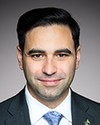Thank you, Chair. Meegwetch.
Greetings, members of Parliament. My name is Justin Marchand. I'm the CEO of Ontario Aboriginal Housing Services.
Our organization is the largest indigenous-led housing provider in Ontario. We have a portfolio of 3,300 rental units, and we serve close to 11,000 people every day through our housing programs and supportive services. We have over 40,900 people on our waiting list. Our organization was also a founding member of the National Indigenous Collaborative Housing Inc., or NICHI.
OAHS was formed over 30 years ago to address the disproportionate housing need among indigenous people living in urban and rural communities across Ontario and to exercise our right to develop indigenous-led housing programs as affirmed in UNDRIP. Three decades later, the needs of our communities have not been adequately met. Indigenous people remain disproportionately underhoused and inadequately housed. The proportion of indigenous people living in urban areas has only continued to climb. In Ontario, 88% of indigenous people live off reserve in urban, rural and northern areas.
There is an extensive body of research documenting the housing crisis as it affects urban indigenous communities.
First, the final report of the National Inquiry into Missing and Murdered Indigenous Women and Girls, released in 2019, identified housing as a critical component of safety and well-being. The final report, critically, mentions housing 299 times. There are 10 calls for justice that refer to housing. In short, the provision of housing is both a preventative measure against violence and a solution to addressing current acts of violence.
Second, this standing committee's 2021 report on urban, rural and northern indigenous housing detailed a tremendous need in urban, rural and northern, URN, indigenous communities. The committee heard the government's distinctions-based approach to indigenous investments in the NHS creates service gaps and does not address the needs of indigenous people living in urban, rural and northern areas. It also heard that a minimum of $1 billion per year would be required to address indigenous housing needs in Ontario alone.
Third, the PBO released a report in 2021 that identified 677,000 indigenous households living in URN areas across the country, and of this total, 124,000 indigenous households are experiencing housing need. Over 37,500 indigenous people experience homelessness in a given year.
Fourth, Scotiabank is acknowledging that Canada is last among G7 nations for housing investments and is calling on Canada to double the level of social housing just to get to the G7 average.
Fifth, in 2022, the federal government's own national housing council released recommendations on URN indigenous housing, indicating a need for a $63-billion investment, and recommended an immediate minimum investment of $6.3 billion over two years.
In our three decades of operation, our organization has witnessed the hollowing out of federal housing investments and the lack of a proactive commitment to an urban indigenous housing policy, despite the data and evidence clearly indicating a significant and embarrassing policy and service gap. Federally, there is no long-term plan to address the end of operating agreements, and as a result we are witnessing the expected displacement of residents living in subsidized housing, an increase in homelessness and growing encampments.
In an era of supposed reconciliation, implementing UNDRIP and addressing MMIWG recommendations, limited federal funding has had mixed results at best. Federal housing funding favours certain geographic areas over others and favours politically and distinctions-based groups rather than being based on need, service and evidence. It fails to address the most urgent and unmet needs and fails to address the disproportionate negative outcomes for demographically disadvantaged groups, thereby perpetuating the practice of genocide recognized in the final report of MMIWG.
We can see how these restrictions impact the results of federal funding. For example, in the RHI funding, out of 10,000 housing units in the first two rounds of housing, only 12 units went to urban indigenous housing providers. Recent federal funding opportunities have been tailored to municipalities with eligibility criteria that have been highly exclusionary of urban indigenous housing providers, and the funding hasn't prioritized the highest demographic need: indigenous women and their families.
OAHS recommends the federal government address the calls for justice of the National Inquiry into MMIWG and the national action plan priorities, especially those related to housing, infrastructure and safety.
It recommends the federal government address the disproportionate housing need in urban, rural and northern indigenous communities by ensuring that all federal funding is in compliance with UNDRIP and the Charter of Rights and Freedoms and allows for indigenous control and self-determination by URN indigenous-led housing providers.
It recommends that the federal government create a sustainable infrastructure program that is cost-matched by all levels of government and that ensures federal housing targets for new builds are matched with adequate infrastructure.
It recommends that the government establish a sustainable source of operating funding to ensure that supportive housing can be built with wraparound supports to address homelessness and housing inadequacy.
It recommends that the government adopt a comprehensive understanding of infrastructure that incorporates funding for community and social infrastructure, including community safety and connection to culture-based supports, education and employment.
Finally, it recommends that the federal government develop a long-term rental subsidy program to support ending chronic homelessness, supporting housing stability and ensuring the safety and well-being of urban indigenous people who are disproportionately homeless and experiencing housing need.
Meegwetch. Thank you for inviting us to your standing committee.




